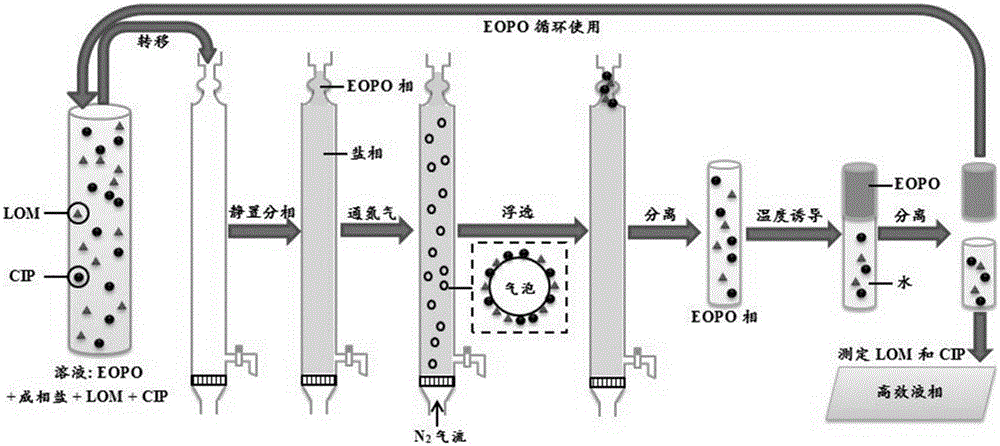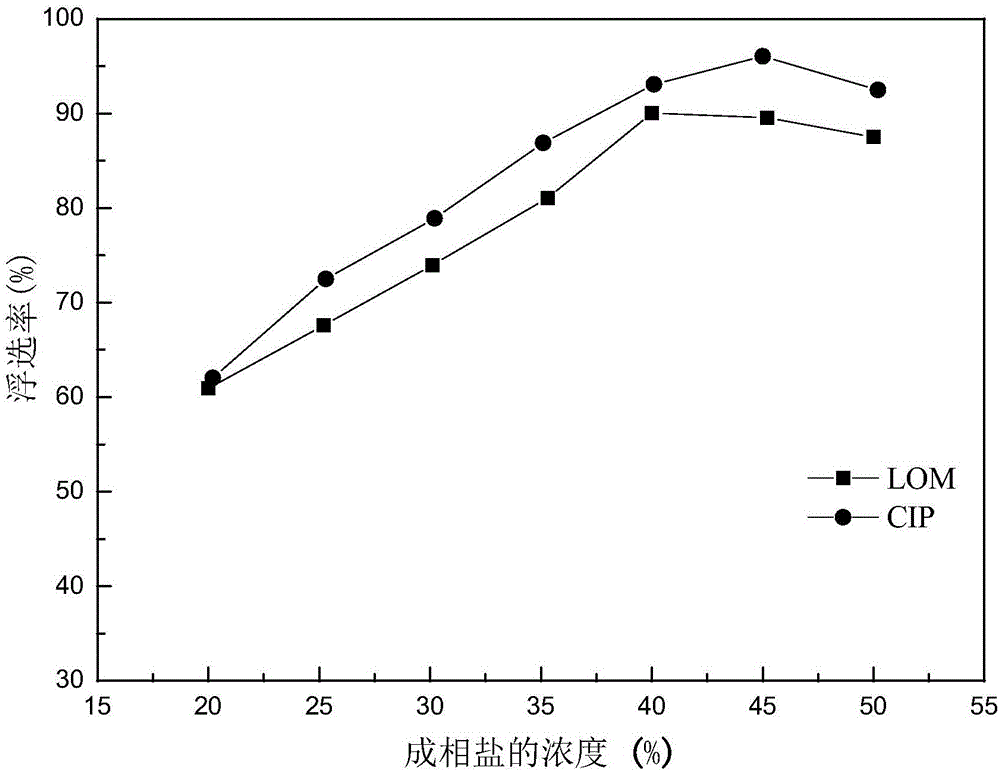Synchronous separation/enriched pretreatment method used for detecting trace fluoroquinolones in environmental water sample
A technology for fluoroquinolones and environment detection, which is applied in measurement devices, material separation, and analysis of materials, etc., can solve the problems of long processing time, secondary pollution of the environment, and large amount of organic solvents used, and achieves easy operation, saving raw materials, Separation-friendly effect
- Summary
- Abstract
- Description
- Claims
- Application Information
AI Technical Summary
Problems solved by technology
Method used
Image
Examples
Embodiment 1
[0040] (1) Mix the aqueous solution containing ciprofloxacin (CIP) and lomefloxacin (LOM) with (NH 4 ) 2 SO 4 Mix and make the phase-forming salt concentration be the (NH 4 ) 2 SO 4 solution;
[0041] (2) (NH) containing ciprofloxacin (CIP) and lomefloxacin (LOM) 4 ) 2 SO 4 After the solution is mixed with the EOPO solution with a concentration of 80% (w / w) according to the volume ratio of 47:3, shake it fully to dissolve it;
[0042] (3) above-mentioned mixed solution is left standstill in flotation cell to make it phase separation;
[0043] (4) Nitrogen is introduced from the bottom of the flotation cell for air flotation solvent flotation, and the nitrogen flow rate is 10-30mL min -1 , the flotation time is more than 30min;
[0044] (5) After the flotation is finished, take out the upper phase (EOPO phase) and transfer it to a container and add distilled water with 10% volume of the upper phase;
[0045] (6) Place the container with the upper phase at a temperatu...
Embodiment 2
[0051] Embodiment 2 (selection of phase forming salt)
[0052] Selection of a suitable phase-forming salt is an important factor in aqueous two-phase extraction. Therefore, the experiment discussed the CIP and LOM in different EOPO-((NH 4 ) 2 SO 4 ,NaH 2 PO 4 ,KCl,Na 2 SO 4 , K 2 HPO 4 or K 2 CO 3 ) distribution behavior in SPATPF, and the flotation rates of each system studied for CIP and LOM are listed in Table 1. As can be seen from the table, EOPO-(NH 4 ) 2 SO 4 The flotation rates of SPATPF to CIP and LOM were significantly higher than other systems, therefore, the selection of (NH 4 ) 2 SO 4 Construct SPATPF as a phase-forming salt to separate and enrich CIP and LOM by flotation.
[0053] Table 1
[0054]
Embodiment 3
[0055] Embodiment 3 ((NH 4 ) 2 SO 4 Effect of concentration on separation / enrichment)
[0056] Experiments discussed for EOPO-(NH 4 ) 2 SO 4 SPATPF at the same temperature, (NH 4 ) 2 SO 4 The influence of the concentration of CIP and LOM on the distribution of CIP and LOM in the system, and the change trend of its flotation rate with the concentration is plotted in figure 2 middle. From figure 2 It can be seen that, in general, the flotation rates of CIP and LOM vary with (NH 4 ) 2 SO 4 The concentration increases, this is because the system (NH 4 ) 2 SO 4 The increase of , will enhance the salting-out ability of the system, promote EOPO to drive CIP and LOM to precipitate from the salt phase, and phase transfer upward; when (NH 4 ) 2 SO 4 After the concentration exceeds 45%, continue to increase (NH 4 ) 2 SO 4 , the flotation rate did not increase significantly, which may be due to (NH 4 ) 2 SO 4 The salting-out effect has reached the maximum value a...
PUM
 Login to View More
Login to View More Abstract
Description
Claims
Application Information
 Login to View More
Login to View More - R&D
- Intellectual Property
- Life Sciences
- Materials
- Tech Scout
- Unparalleled Data Quality
- Higher Quality Content
- 60% Fewer Hallucinations
Browse by: Latest US Patents, China's latest patents, Technical Efficacy Thesaurus, Application Domain, Technology Topic, Popular Technical Reports.
© 2025 PatSnap. All rights reserved.Legal|Privacy policy|Modern Slavery Act Transparency Statement|Sitemap|About US| Contact US: help@patsnap.com



